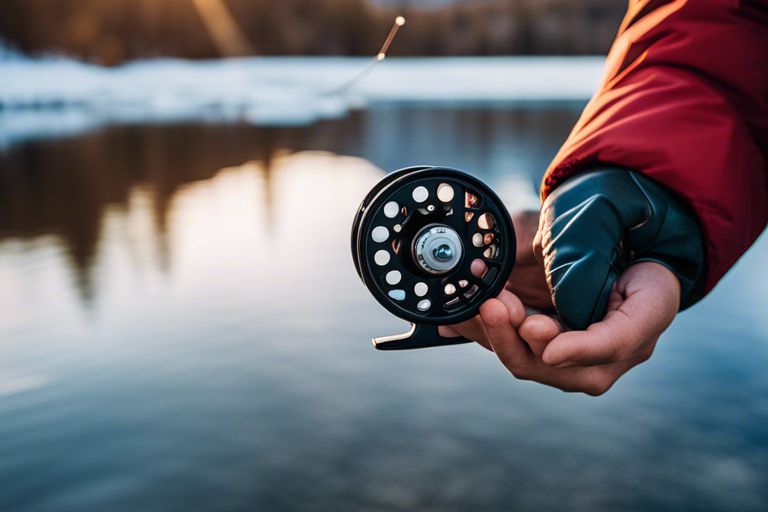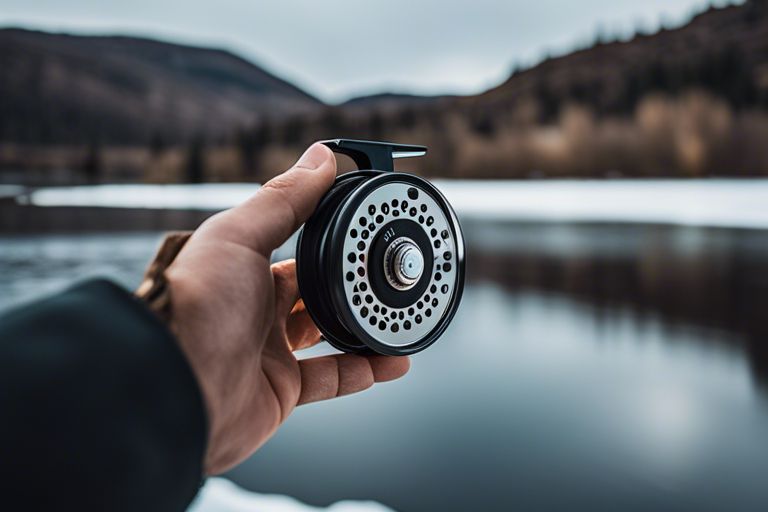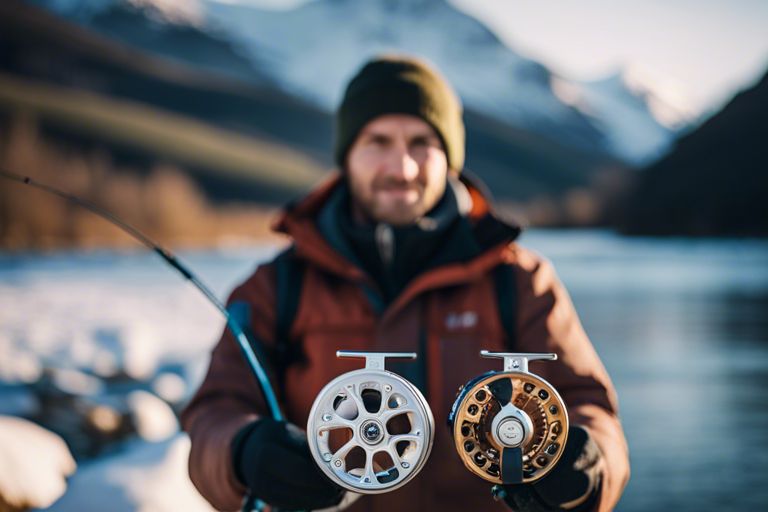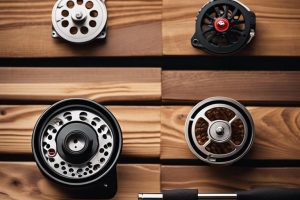Fly fishing in cold weather presents unique challenges, especially when it comes to choosing the right gear. You want a fly reel that not only withstands frigid temperatures but also performs reliably in icy conditions. Your selection will greatly affect your fishing experience, from the materials used to the design of the reel. In this guide, we’ll explore necessary factors to consider to ensure your fly reel works seamlessly in the cold, keeping your focus on landing that perfect catch.

Understanding Cold Weather Fishing Challenges
Before heading out for your next cold weather fishing trip, it’s necessary to understand the unique challenges these frigid conditions pose on your fly reels and overall fishing experience. Cold temperatures can significantly impact your equipment’s performance and affect the way you handle your gear. If you’re looking for specific insights into selecting a Cold weather reel, being informed can help you make better decisions to enhance your angling in less-than-ideal conditions.
How Cold Temperatures Affect Fly Reels
One of the primary challenges you’ll encounter when fishing in icy temperatures is the impact of the cold on your fly reel’s materials and mechanics. Below is a breakdown of how these elements interact with colder weather:
| Material Rigidity | Most metals can become more brittle in extreme cold, which may affect the durability of your reel. |
| Lubrication Issues | Common grease and oil manufacturers use can thicken or lose effectiveness, leading to sluggish drag systems. |
| Line Freezing | Your fly line may freeze to the reel or become less manageable, resulting in poor casting performance. |
| Corrosion | Moisture combined with cold can lead to corrosion, especially in less resistant materials. |
Common Issues with Fly Reels in Cold Weather
Even the most seasoned anglers can face issues when using fly reels in cold weather. The combination of freezing temperatures and moisture can create a multitude of problems, such as line freezing up on the reel, sticky drag systems, and a heightened risk of corrosion. These elements can seriously hinder your ability to catch fish and can even lead to equipment failure when you need it most.
Reels might also show performance inconsistencies, especially if they’re not designed for cold weather conditions. If ice forms or moisture enters the internals, you might struggle with pulling line smoothly or controlling the drag. Working around these potential issues is crucial for a successful fishing trip. Ensuring your fly reel is cold-weather-friendly will make all the difference in your performance and enjoyment out on the ice or snow.
Key Factors to Consider When Selecting a Fly Reel for Cold Weather
Assuming you’re gearing up for some winter fly fishing, choosing the right reel can significantly enhance your experience in freezing temperatures. There are several key factors you should evaluate to ensure your gear functions optimally and withstands the harsh winter conditions. These factors include materials and construction, drag system design, and spool and line capacity.
- Materials and Construction
- Drag System Design
- Spool and Line Capacity
Assume that you want to invest in a fly reel that can handle frigid temperatures and ice-laden environments effectively.
Materials and Construction
With cold weather fishing, the materials and construction of your fly reel play a crucial role in its performance. Aluminum and composite materials are often preferable as they are lightweight yet strong, allowing them to endure freezing temperatures without becoming brittle. Additionally, reels that are sealed against environmental elements will keep ice and moisture from entering, which can affect the mechanical integrity of the reel.
Moreover, look for models that incorporate corrosion-resistant finishes. These features will help preserve the reel’s functionality against saltwater or brackish environments, which may be encountered even in cooler climates. A well-constructed reel ensures that you won’t face unexpected failures in the midst of your fishing adventures.
Drag System Design
Drag systems are vital for controlling fish movement during a fight, and in cold weather, their performance can be challenged by freezing temperatures. A reliable drag system must operate smoothly, allowing for consistent pressure on the fish without unnecessary friction. Look for reels equipped with sealed drag systems that can prevent moisture from freezing up the mechanism and ensure that you maintain the desired drag pressure throughout your fishing session.
Moreover, consider the type of drag system, whether it’s a pawl or disc system, and how well it can handle fluctuations in temperature. A disc drag with carbon or Teflon washers will typically provide more consistent performance under diverse conditions, which is particularly important when battling powerful fish in cold waters.
Factors to account for include the adjustability of the drag system, allowing you to make quick changes depending on fish behavior or current conditions. Having a dependable drag system will enhance your confidence when hooking into larger fish, ensuring you can react and adapt without hesitation.
Spool and Line Capacity
Now, as you select a fly reel, consider the spool and line capacity that match your fishing style and the species you intend to target. A larger capacity spool can be beneficial in cold weather fishing, as it allows for increased line storage, accommodating for the chance that longer runs from fish may occur in icy waters. Additionally, a good line capacity ensures you have enough backing to withstand the sudden lunges from larger fish.
Furthermore, be sure to match the spool width with the type of line you will be using, as overly narrow spools may twist or tangle easily during casting. Optimal design and size can help reduce drag and enhance your overall fishing experience, especially when you’re out braving the cold.
Capacity is a critical consideration for minimizing the risk of losing your catch. If your spool capacity is insufficient, you risk being underprepared for a large fish’s run, which can easily lead to break-offs or lost opportunities. By selecting a reel that provides ample spool capacity, you ensure that you are ready for anything that may swim your way.
How to Choose the Right Fly Reel for Your Cold Weather Fishing Needs
Assessing Your Fishing Style and Environment
To ensure a successful cold weather fishing experience, it’s imperative for you to assess your fishing style and the environment where you’ll be casting. Cold weather conditions can significantly affect not only the fish behavior but also your gear performance. Consider whether you’re wading into frigid waters or fishing from a boat; each scenario may demand different reel features. You should also take into account the specific weather trajectories, including potential ice formations and wind conditions, as these factors will influence the type of reel you’ll need.
Cold weather fishing often means exposed gear to moisture and freezing temperatures, so your choice of reel should focus on durability. Look for materials that resist corrosion and are equipped to handle temperature fluctuations without compromising performance. High-quality seals and protective coatings are imperative, as they help keep ice and water at bay, ensuring your reel operates smoothly throughout your time on the water.
Considering the Type of Fish You’re Targeting
Fish species exhibit varying behaviors in cold weather, making it vital for you to consider what type of fish you’ll target. Larger species such as trout and steelhead may be more sluggish in colder temperatures, requiring you to adjust your retrieval speed and technique. A reel designed for precision and sensitivity will enhance your ability to detect subtle bites, which can be especially challenging when fish are less active.
Different fish species also demand different gear specifics; for instance, if you’re after fast-moving fish, opt for a reel with a higher retrieve rate. This not only aids in bringing the fish in quickly but also helps you manage the line better as you navigate potentially icy waters. Match the reel’s diameter and line weight with the characteristics of the species you’re pursuing to enhance your fishing efficiency in these cold conditions.
Balancing Performance and Budget
Style is crucial when balancing performance with budget in your search for the perfect fly reel. Cold weather fishing can sometimes lead to unforeseen gear strains, so you might be tempted to over-invest in a product that promises high performance. However, you need to strike a balance between cost-effectiveness and reliability. Research brands that offer quality options without breaking the bank, as many reputable manufacturers provide excellent cold-weather reels at competitive prices.
As you navigate budget concerns, consider how often you plan to fish in cold conditions. If this is an infrequent venture, it may be wise to choose a mid-tier reel that meets your imperative performance needs without unnecessary expenditures. However, if you’re planning regular excursions, investing in a top-quality reel becomes a practical choice to ensure lasting performance during those icy fishing trips.
A well-balanced approach to performance and budget will give you the confidence to tackle any cold weather fishing scenario. Remember that quality materials and intelligent designs will not only improve your fishing experience but also provide long-term value, making it a worthwhile investment for your fishing endeavors.

Tips for Maintaining Your Fly Reel in Cold Weather
Once again, as an avid angler, you know that cold weather fishing can be exhilarating, but it does require specific care for your fly reel to ensure optimal performance. To keep your gear functioning smoothly even in freezing temperatures, it’s crucial to implement maintenance practices that will prevent issues like freezing line and reel malfunctions. Here are some tips to help you maintain your fly reel during those chilly outings:
- Inspect your reel for any signs of wear and corrosion before each trip.
- Lubricate moving parts with appropriate low-temperature grease.
- Ensure all seals are intact to prevent water from entering the reel.
- Use a fly line that is rated for cold weather to minimize freezing issues.
- Keep your reel clean and free of salt or grime that can exacerbate problems.
After implementing these maintenance strategies, you will be much better equipped for a successful day on the water, even when temperatures drop.
Pre-Trip Preparation and Maintenance
On the eve of your fishing trip, it’s wise to give your fly reel a thorough inspection. Start by checking for any damage or wear that may have gone unnoticed. Pay special attention to the drag system, as it should function smoothly and consistently to handle the stress of icy conditions. Cleaning the reel and applying relevant lubricants tailored for cold weather will also enhance its performance, preventing it from freezing up in unexpected moments.
Additionally, considering the type of line you’ll be using is vital. Make sure your fly line is designed for cold weather; this should help prevent it from becoming overly stiff and unmanageable in low temperatures. Organizing your tackle and ensuring that you have backup gear ready to go can also save you from frustration later in the day.
In-Field Care and Troubleshooting
Your fly reel may encounter challenges when faced with extreme cold, so being prepared to tackle issues will enhance your fishing experience. Keep an eye out for ice build-up on your reel and fly line. If you notice any, it’s crucial to clear it promptly, as this could hinder performance and ultimately affect your catch rate. Carrying a cloth or a soft towel to wipe off moisture and ice is an easy fix that can significantly improve your reel’s function.
PreTrip preparation doesn’t end when you leave your home base. Being adaptable and ready to address problems as soon as they arise is key. If you encounter a frozen clutch or a stuck drag, ensure you have tools on hand that can help you make quick adjustments. Understanding your gear and how to troubleshoot typical in-field issues will keep your focus on enjoying the experience rather than wrestling with equipment challenges.
Post-Trip Cleaning and Storage
Any time spent outdoors in cold weather can take a toll on your fly reel, so post-trip cleaning is non-negotiable for long-term functionality. After a fishing outing, it’s important to rinse your reel thoroughly with fresh water to remove any ice, salt, or debris that may have accumulated during your time on the ice. Ensuring the reel is completely dry before applying a light lubricant will help prevent corrosion and damage.
Maintaining your fly reel doesn’t end after the first cleaning. Storing it in a temperature-controlled environment helps protect it from extreme fluctuations in temperature that could lead to condensation and rust. Proper storage practices, including removing the line from the reel if not used for an extended period, will ensure your gear remains in top-notch condition for your next adventure.

The Importance of Sealing and Waterproofing in Cold Weather Fly Reels
Keep in mind that the conditions you face while fly fishing in cold weather can pose significant challenges for your gear. Moisture and ice can wreak havoc on unsealed reels, leading to malfunctions and decreased performance. Therefore, when selecting a fly reel for these harsh conditions, it’s crucial to understand how sealing and waterproofing work to ensure your equipment can withstand freezing temperatures without compromising your fishing experience.
How Sealing and Waterproofing Work
To ensure that your fly reel remains fully functional in frigid environments, manufacturers employ various sealing techniques to protect the internal components from water, ice, and debris. This often includes the use of O-rings and special gaskets that create a barrier between the reel’s internals and the external elements. Additionally, some reels utilize epoxy or other coatings to provide further protection against corrosion and wear caused by exposure to harsh weather conditions. Understanding these mechanics helps you appreciate the importance of investing in a reel designed specifically for cold weather.
To add another layer of protection, many high-quality fly reels incorporate drainage systems that allow any trapped water to escape, preventing frost buildup and ultimately avoiding the internal freezing of components. These systems are designed to ensure that even if moisture manages to enter the reel, it won’t remain trapped long enough to cause damage. By knowing how these mechanisms function, you can confidently choose a reel that will perform throughout your winter fishing adventures.
Benefits of Sealed and Waterproof Fly Reels
Now, let’s explore into the distinct advantages that sealed and waterproof fly reels offer, particularly in cold weather fishing scenarios. The foremost benefit is reliability; when your gear is protected against moisture and freezing temperatures, you can focus more on your technique and less on worrying about potential failures. This peace of mind can significantly enhance your overall fishing experience.
Now, consider the longevity of your investment. A sealed fly reel not only withstands cold conditions but also minimizes wear and tear over time. Since these reels resist corrosion and the buildup of ice and debris, they require less maintenance and, therefore, are more cost-effective in the long run. Choosing a quality reel with superior sealing technology means that you’re not only making a smart purchase for the cold weather but for your future fishing endeavors as well.
For instance, many anglers report that their sealed fly reels often last significantly longer than their unsealed counterparts because they stand up to the rigors of winter fishing. This durability can translate into greater seasons spent on the water without the need for costly repairs or replacements. You get to maximize your time outdoors, casting your line into the cold waters without the fear of dealing with a malfunctioning reel.
What to Look for in a Sealed and Waterproof Fly Reel
For optimal performance in freezing conditions, you should look for specific features when selecting your fly reel. First, check for an effective sealing system, such as O-rings or gaskets, that creates a barrier to prevent water and ice from entering the reel. Additionally, reels with a corrosion-resistant finish are preferable, as they help safeguard the metal components from damage over time. The material of the reel itself can also play a significant role; lightweight yet durable materials like aluminum provide strength without unnecessary weight.
For an extra layer of protection, consider those models that come with advanced drainage systems to allow for any accumulated water to escape quickly. Furthermore, reading user reviews and understanding the warranties offered can also give you insight into the reel’s performance under extreme conditions. Equip yourself with the right knowledge to choose a fly reel that will not fail you when you need it most.
Look for features like an adjustable drag system that maintains its performance in cold weather, which can be vital when battling fish in icy waters. Having a reel that retains smooth engagement under these circumstances will enhance your fishing experience and help you react swiftly when you feel that tantalizing tug on your line. A well-versed angler knows that every detail counts, especially in challenging environments, so be sure to choose wisely for the conditions you are up against.
Additional Features to Consider for Cold Weather Fly Reels
Your choice of fly reel can significantly impact your fishing experience, especially in freezing temperatures. As you navigate the challenges of cold weather fishing, focusing on additional features can enhance your performance and enjoyment. These features, including line retrieval and pickup, handle design and ergonomics, and weight and portability, are crucial in ensuring that your setup is ready for the harsh conditions you may encounter.
Line Retrieval and Pickup
Line retrieval and pickup are vital considerations when selecting fly reels for cold weather fishing. In freezing temperatures, line can become stiff and harder to manage, making efficient retrieval vital. Look for reels that have a smooth and reliable drag system, as well as a quick line pickup rate. A reel designed for fast line retrieval will help you maintain control and responsiveness, allowing you to keep up with dynamic fishing situations, even when faced with the challenge of icy lines.
Additionally, consider the ratio of the reel’s retrieve. A higher ratio will allow you to bring in line quickly, which is especially beneficial when dealing with fish that have a tendency to dive for cover in cold water. Make sure to test the reel’s drag system to ensure that it performs well in low temperatures, as some materials can stiffen or lose effectiveness when exposed to extreme chills.
Handle Design and Ergonomics
While fishing in cold weather, handle design and ergonomics play a crucial role in your comfort and control. Look for reels with ergonomic handles that are easy to grip, even when wearing gloves. A comfortable handle helps prevent fatigue and allows you to maintain precision while casting or retrieving, which is especially important in cold conditions where your dexterity may be compromised.
Weather can exacerbate discomfort, as cold fingers can lead to poor grip and decreased sensitivity. Reels that feature larger, textured handles and materials that provide warmth will enable you to fish more effectively. You might also consider reels with alternative grip designs or even interchangeable handle options, allowing you to find the best fit for your personal fishing style and conditions.
Weight and Portability
With cold weather fishing often requiring you to traverse rugged terrains or maintain mobility while waiting for bites, the weight and portability of your fly reel are paramount. Lightweight reels can reduce overall fatigue during long fishing sessions and help you maintain agility on slippery surfaces. Consider the reel’s material, as aluminum and composite options typically offer excellent durability without excess weight.
Reels that are compact and easy to pack will make your fishing trips more convenient. Look for models that fit neatly into your gear bag without adding bulk, allowing you to keep your overall tackle lightweight. Lightweight reels enable you to focus on the water without being encumbered by heavy equipment, which is vital when fishing in frigid conditions.
Reels designed for portability will also often come with protective cases or gear attachments, allowing you to safely transport your equipment while minimizing wear and tear from the elements. Investing in a reel that addresses these aspects can significantly enhance your cold-weather fishing experience, making it easier for you to enjoy your time on the water.
Summing Up
Considering all points, selecting the right fly reel for cold weather fishing is crucial for ensuring an enjoyable and successful experience on the water. You need to focus on features such as materials that resist freezing, drag systems that function smoothly in low temperatures, and overall durability to withstand harsh conditions. It’s important to choose reels designed specifically for cold weather, as they will have undergone testing to ensure optimal performance when the mercury dips. Additionally, consider the weight and balance of your setup, making sure that your reel complements your rod and line for superior control and handling.
Your choice of fly reel can significantly affect your fishing experience, particularly in challenging winter conditions. By prioritizing quality, functionality, and suitability for cold temperatures, you can enhance your chances of landing that prized catch. So, take your time to research and invest in a reel that fits your needs, ensuring you’re well-prepared for whatever the winter weather brings. With the right equipment, you can enjoy the unique thrill of fishing in the cold while confidently braving the elements.
FAQ
Q: What features should I look for in a fly reel for cold weather fishing?
A: When identifying a fly reel for cold weather fishing, you should consider several key features:
1. **Materials**: Opt for reels made from corrosion-resistant materials such as aluminum or stainless steel that can withstand the harsh conditions.
2. **Sealing and Lubrication**: Look for models with sealed drag systems to prevent ice and moisture intrusion, along with high-quality, cold-weather lubricants that won’t thicken in low temperatures.
3. **Weight and Balance**: Choose a reel that pairs well with your rod while remaining lightweight to prevent fatigue during long fishing sessions. Balancing the reel with the rod ensures better casting and control.
Q: How does cold weather affect the performance of fly reels?
A: Cold weather can significantly impact the performance of fly reels in several ways:
1. **Drag System**: In low temperatures, hydraulic drag systems can become less responsive as the lubricants may thicken, leading to inconsistent drag performance. A good cold-weather reel should have a reliable drag system that maintains performance irrespective of the temperature.
2. **Line Freezing**: Fly lines can freeze on the guides and the reel, causing tangles and reduced casting distance. Using reels that provide smooth line retrieval and have a larger arbor can mitigate this issue, allowing for faster line pickup and reducing freeze time.
3. **Reel Functionality**: Components such as the reel handle and drag knob can become stiff and difficult to operate in freezing conditions. Look for reels designed with wider grips and easy-to-manage controls for easier handling even in cold weather.
Q: Can I use my regular fly reel in cold climates, or should I invest in a specialized one?
A: While you can use your regular fly reel in cold climates, investing in a specialized cold-weather fly reel is highly advisable for several reasons:
1. **Durability**: Regular reels may not be designed to withstand the extreme conditions, resulting in potential failure or decreased performance due to ice or moisture exposure.
2. **Consistent Performance**: Specialized reels typically feature components that perform reliably in cold weather. These reels often have superior drag systems and materials that function well under freezing conditions.
3. **Enhanced Enjoyment**: Fishing in cold weather can be challenging. Having gear specifically suited for the environment can enhance your experience, allowing you to focus on fishing rather than worrying about gear malfunctions.


